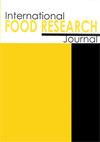Antioxidant activity and metabolite changes in Centella asiatica with different drying methods using FTIR- and quantitative HPLC-based metabolomics
IF 0.7
4区 农林科学
Q4 FOOD SCIENCE & TECHNOLOGY
引用次数: 0
Abstract
Centella asiatica, known as Indian or Asiatic pennywort, is consumed raw as salad or used as a brain tonic, treatment of Alzheimer’s disease, and memory improvement. Differences in the drying method will lead to different levels of phytochemical profile and biological activity. Therefore, the present work aimed to investigate the Fourier transforms infrared (FTIR) spectra fingerprint profiles, HPLC analysis of four bioactive compounds, and antioxidant activity of C. asiatica samples exposed to various drying methods, including air-, oven-, and sun-drying. Results showed that all samples had identical FTIR spectra patterns, but there were differences in the absorbance intensities at 1692 and 1634 cm-1, showing the effect of drying methods on the content of extracts’ bioactive compounds. These differences were analysed by chemometrics namely principal components analysis (PCA), and groupings were shown for the three samples. Based on the IC50 values, oven-drying (OD) had the highest antioxidant activity, followed by sun-drying (SD) and air-drying (AD), with IC50 values of 52.25, 94.18, and 99.29 μg/mL, respectively. HPLC analysis showed that OD had a higher percentage for madecassoside and asiaticoside with values of 0.86 and 0.96%, respectively, compared to SD and AD. Meanwhile, AD had the highest content of madecassic and asiatic acids, with values of 0.50 and 0.48%. The absorbance and antioxidant activity data for the three C. asiatica extracts were analysed for the correlation using an orthogonal partial least square. Results showed that at 1006 - 989 cm-1, it positively correlated with antioxidant activity, and could be identified as the C–O functional group of alcohol and phenol.利用基于傅立叶变换红外光谱和定量高效液相色谱的代谢组学分析不同干燥方法下积雪草的抗氧化活性和代谢物变化
积雪草被称为印度或亚洲五味子草,可作为沙拉生吃,也可用作补脑药、治疗老年痴呆症和改善记忆力。干燥方法的不同会导致植物化学成分和生物活性的不同。因此,本研究旨在调查傅立叶变换红外光谱(FTIR)指纹图谱、四种生物活性化合物的高效液相色谱分析以及风干、烘干和日晒等不同干燥方法下香附样品的抗氧化活性。结果表明,所有样品的傅立叶变换红外光谱图完全相同,但在 1692 和 1634 cm-1 处的吸光强度存在差异,这表明干燥方法对提取物生物活性化合物含量的影响。化学计量学即主成分分析法(PCA)对这些差异进行了分析,并对三种样品进行了分组。根据 IC50 值,烘干(OD)的抗氧化活性最高,其次是日晒(SD)和风干(AD),IC50 值分别为 52.25、94.18 和 99.29 μg/mL。高效液相色谱分析显示,与 SD 和 AD 相比,OD 的马黛茶苷和积雪草苷的比例较高,分别为 0.86% 和 0.96%。同时,AD 的马黛酸和积雪草酸含量最高,分别为 0.50% 和 0.48%。采用正交偏最小二乘法对三种茜草提取物的吸光度和抗氧化活性数据进行了相关性分析。结果表明,1006 - 989 cm-1 处与抗氧化活性呈正相关,可确定为醇和酚的 C-O 官能团。
本文章由计算机程序翻译,如有差异,请以英文原文为准。
求助全文
约1分钟内获得全文
求助全文
来源期刊

international food research journal
Agricultural and Biological Sciences-Food Science
CiteScore
1.40
自引率
0.00%
发文量
75
期刊介绍:
The International Food Research Journal (IFRJ) publishes papers in English, six (6) issues a year with the coverage of:
Food Science and Technology
Nutrition and Dietetics
Agriculture, multidisciplinary
Chemistry, multidisciplinary
The scope of the Journal includes:
Food Science, Food Technology and Food Biotechnology
Product Development and Sensory Evaluation
Food Habits, Nutrition, and Health
Food Safety and Quality
Food Chemistry, Food Microbiology, Food Analysis and Testing
Food Engineering
Food Packaging
Food Waste Management
Food Entrepreneur
Food Regulatory
Post-Harvest Food Management
Food Supply Chain Management
Halal Food and Management
 求助内容:
求助内容: 应助结果提醒方式:
应助结果提醒方式:


